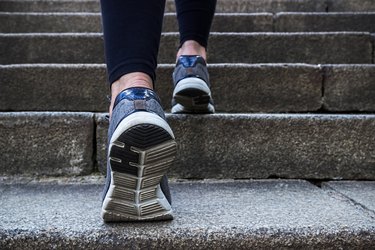
If you look in the mirror and see more jiggle in your middle than you'd like, brace yourself for some good news and bad news: You can lose that extra belly fat, but there are no magic exercises for middle stomach fat. Instead, you'll have to lose fat from all over your body.
The Spot-Reduction Myth
Video of the Day
As explained by Jonathan Ross, author and award-winning master trainer for the American Council on Exercise, the idea of separating your rectus abdominus into upper and lower abs (or upper, lower and middle, if you prefer) just doesn't exist in the eyes of science.
Video of the Day
That doesn't mean you're doing something wrong if you put more stress on different parts of your rectus abdominus during certain exercises. Ross notes that empirically, if you hold your ribs fixed and move your hips closer to your ribs, you'll feel the effort more in the lower portion of your rectus abdominus. Whereas, if your ribs move closer to your hips, you'll probably feel it more in the upper portion of your rectus abdominus.
In much the same way, you can feel greater strain on different areas of your hamstrings, lats or any other major muscle group. While that fine-tuned information may be useful for bodybuilders seeking to hypertrophy one small section of a particular muscle, it doesn't make any difference in how your body burns fat — from your stomach or anywhere else.
This has been proven again and again in scientific studies, with one of the most relevant to this topic being a small study of 24 subjects, published in the September 2011 issue of the Journal of Strength and Conditioning Research. Researchers had half the subjects do abdominal exercises for six weeks, while the other half acted as a control group. Although the abdominal exercises increased the subjects' muscular endurance, it didn't affect the levels of fat in their abdomen.
Read more: The Truth About Targeted Weight Loss
How to Lose Stomach Fat
Here's what does work to lose excess body fat, based on research findings from the National Weight Control Registry, which tracks more than 10,000 individuals who have lost weight and keep it off:
- Increasing physical activity
- Modifying food intake
The vast majority of entrants in the registry used both strategies. Your goal is to establish a calorie deficit — burning more calories than you take in — so that your body must "burn" stored fat as energy. Although you can't pick and choose in what progression the fat comes off your body, if you keep at it the fat will come off everywhere, including your middle and lower stomach.
The Centers for Disease Control and Prevention recommend losing 1 to 2 pounds per week as a healthy rate of weight loss. That works out to a calorie deficit of 500 to 1,000 calories per day, but it doesn't mean you should starve yourself. As noted by Harvard Health Publishing, you shouldn't drop your daily calorie intake below 1,200 calories (for women) or 1,500 calories (for men) without a doctor's supervision.
Instead, start with the U.S. Department of Health and Human Services estimates of recommended calorie needs; these estimates are for maintaining weight. Then tweak your diet choices and exercise habits until you reach the desired daily calorie deficit.
For example: To lose 1 pound per week (a daily 500-calorie deficit) you could eat the recommended number of calories and burn 500 calories per day through exercise, or decrease your calorie intake by 250 calories and burn an additional 250 calories per day through exercise.
What type of exercise should you do? Although you can use strategies like high-intensity interval training (also known as HIIT) to maximize your calorie burn, the most commonly reported form of activity in the National Weight Control Registry data banks is simply walking.
Ultimately, any type of physical activity helps you burn more calories and set up that calorie deficit. Cardio workouts tend to be particularly good for this, and the more intensely you exercise, the faster you'll burn those calories. But ultimately, the best workouts for weight loss and health are the ones you'll stick with over the long term, so try to choose activities that you enjoy for their own sake.
Read more: How to Maximize Your Cardio Workouts for Weight Loss
- American Council on Exercise: "Can You Train Upper and Lower Abs Separately?"
- National Weight Control Registry: "NWCR Facts"
- Centers for Disease Control and Prevention: "What Is Healthy Weight Loss?"
- Harvard Health Publishing: "Calorie Counting Made Easy"
- U.S. Department of Health and Human Services: "Dietary Guidelines for Americans, 2015-2020: Appendix 2. Estimated Calorie Needs Per Day by Age, Sex, and Physical Activity Level"
- Journal of Strength and Conditioning Research: "The Effect of Abdominal Exercise on Abdominal Fat"